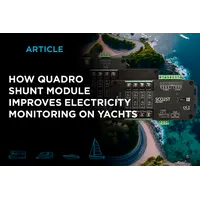In this article we’ll explain what benefits you get from installing a tank level module into your yacht monitoring system. In this review, topRik experts examine in detail the operating principles of tank level modules using the example of Simarine monitoring systems, the equipment of which is widely represented in our marketplace.
What is especially interesting: this manufacturer produces not just shunts with the ability to monitor the condition of batteries and the level of liquids in yacht tanks (SC503 and SC303) or shunt modules with the same capabilities (for example, Quadro shunt and tank module SCQ25T). At topRik marketplace you can also buy tank level module ST107, which is designed specifically for monitoring the level of any liquids in any tanks of a yacht or motorhome.
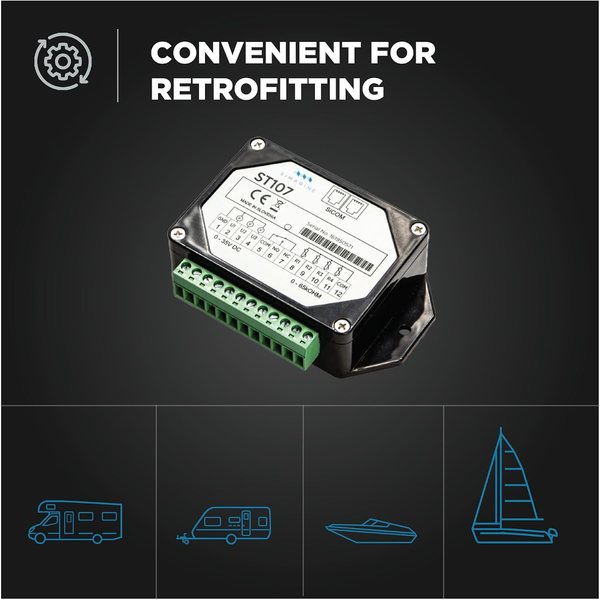
What Is It and What Is the Tank Level Module For?
Any vessel, even a small one, has at least one reservoir - a fuel tank. And the larger and more comfortable the yacht, the greater the number of tanks it is equipped with. After all, in addition to fuel tanks (including spare ones), you should store drinking water separately and somewhere fill sea (river) water for domestic needs. Of course, you also store black and gray waters in separate tanks until it becomes possible to drain them in a specially designated place, and not pollute the world's oceans with your waste. And you still need to control the level of hot water in the boiler, for example.
And of course, you cannot do without monitoring the condition of the tanks if you are the owner of a camper, caravan or any “motorhome”, where the number of tanks with different liquids will rival their number on small vessels.
Definition and Purpose of Tank Level Module
Tank level module is a device designed to determine the level of contents in open and closed tanks, storage facilities and other containers equipped with vehicles: yachts, boats, ships, vans, campers, etc. The contents mean various types of liquids, in our case this is fuel, drinking water, hot water in the boiler, sea water for domestic needs, the so-called gray and black, that is, waste water.
Let’s immediately agree that in this review we are talking about pleasure yachts and campers or racing vessels, and not about oil tankers, grain carriers or other ships and vehicles that transport liquid and bulk cargo in huge tank-type tanks. There, of course, liquid level meters of various designs are also used without fail, although the principle of their operation is practically the same.
The main difference between a yacht or camper tank level module and a level switch is the ability to measure level gradations, not just its boundary values, and transmit measurements in real time to a monitor or control panel.
Based on the results of level measurements, one judges the volumetric amount of a substance contained in reservoirs (tanks, cisterns, tanks, etc.). For this, either measuring containers of a constant (height) cross-section are used (for example, measuring tanks of volumetric flow metering installations), or special calibration tables that assign each current level value to the tank volume value. The latter are more often used on special vehicles involved in transportation.
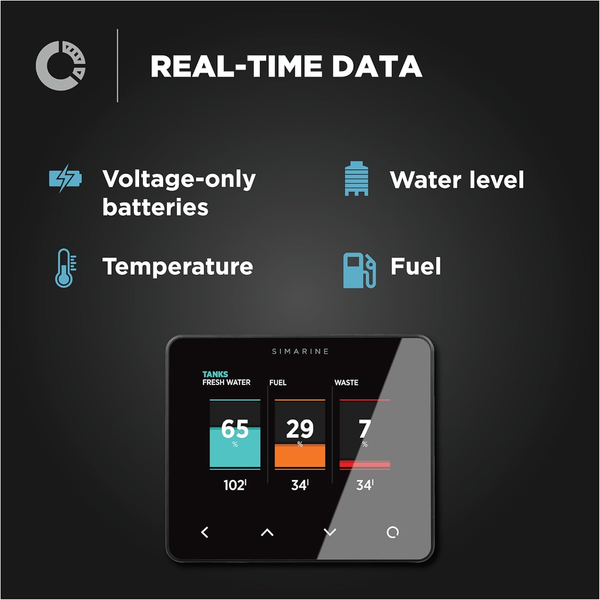
Different Types of Tanks on a Yacht
The main tanks that more or less comfortable yachts are equipped with are containers for storing fuel and various types of water: drinking, hot, sea, black or gray.
Reservoirs In the Yacht's Water Supply System
In the minimum version, the boat’s water supply is a large-capacity bottle of drinking water, but the maximum is almost unlimited. Components of water supply systems are produced by well-known companies Plastimo, Marco, CAN-SB and others. Their plastic and elastic tanks of various configurations and volumes are widely represented in the topRik marketplace.
Flexible water tanks are used for limited internal spaces on small yachts. They do not require fasteners and, when filled, occupy the entire space below the deck, but they are expensive.
Nice and durable plastic tanks don't come cheap either. In this regard, some shipyards that produce aluminum boats offer welded tanks of their own manufacture as an option to reduce the cost. But here it is worth considering that a plastic tank, which is not inferior in strength to a metal one, is not dangerous from any type of corrosion, including electrochemical, which is the most dangerous due to the speed of its development. For example, in areas of contact between aluminum and steel, corrosion will be inevitable if salt water enters. The greater the potential difference, the faster the destruction will occur. And it’s much easier to care for plastic tanks than metal ones.
Water from the tank should flow into the tap. To create pressure in water supply systems, two types of pumps are used. These are foot pumps installed next to the sink, and electric pumps of the diaphragm or gear type. Electric ones, in turn, are divided into pumps with forced activation (flick the switch, open the tap, and water flows) and automatic pumps, which turn off when a certain pressure level is exceeded. They all also differ in performance.
At the top there are hydrophores, or pumping station, as they are also called. They are a pump combined with a pressure tank, which maintains pressure in the water supply system and thus controls the operation of the pump motor. This ensures minimal noise, stable water pressure and energy savings. And for this, the pressure tank must be equipped with an effective water level sensor.
Boats and yachts with such a pumping station can have a fairly extensive water supply scheme. This is a sink in the galley, a washbasin and shower in the latrine, a sink in the cockpit and a shower on the bathing platform. But washing dishes with cold water or taking a shower in cloudy weather is not always a pleasure.
This is where boilers come to the rescue. These are thermally insulated reservoirs, which receive water from the hydrophore, heated from the second circuit, where the liquid circulates, cooling the running engine. The volume of water heated for a shower or galley usually starts at 20 liters - it makes no sense to produce smaller boilers.
Hot and cold water on the boat is supplied to faucets, from where it flows into sinks and shower heads. But such a very convenient thing as a shower box with a mixer for cold/hot water, a hose and a shower head with a dosing valve, which is closed with a lid when not in use, is used only on the decks of boats and their bathing platforms.
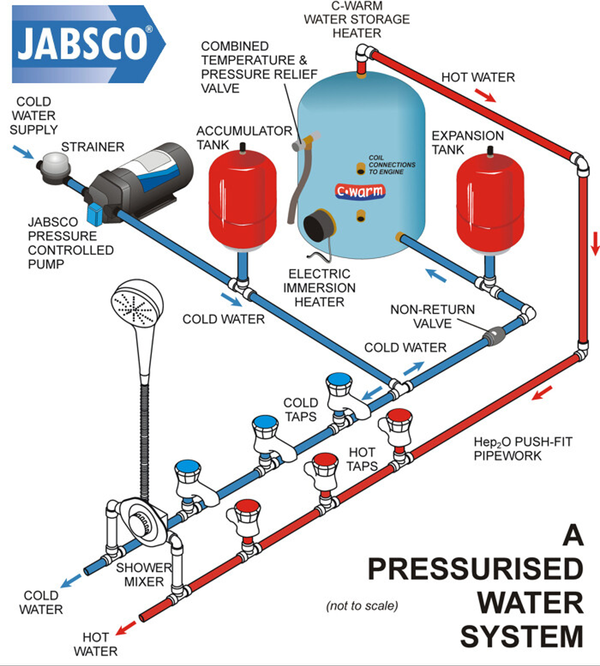
Previously, in the vast majority of cases, on boats 7–9 meters long, water from the sinks flowed by gravity through the scupper overboard. The soapy liquid was also pumped out there after washing the crew. But with changes in environmental legislation in most countries on the planet, these so-called black and gray waters must be collected in special tanks for pumping into the marina sewer.
Owners of boats equipped with marine latrines also encounter problems with pumping into a septic tank. The simplest system of amenities is chemical toilets. When filling the drain block, I removed it and drained the contents in a secluded place.
But yachts equipped with flushing toilets, which can be either manual or electric, are divided into two types. These are those in which, when pumped and flushed with sea water, everything is washed overboard, and those where a septic tank is built into the sewerage system. In addition to the neck for pumping waste into the sewer system of special floating collectors or marinas, the septic tank must also be equipped with a level measurement sensor.
Yacht Fuel System Tanks
In terms of design characteristics, fuel tanks for yachts and boats of various sizes and configurations are divided into the following types:
- built-in - are non-removable options, used for motors with a power of no more than 6 l/s, installed on small boats and hidden under a cover covering the engine;
- portable - they are a removable type of tank, the designs are ideal for small boats and inflatable boats, they are popular among tourists and fishermen who go long distances;
- stationary - installed with powerful motors, have increased capacity and are used on large boats or yachts.
Based on the material used, boat fuel tanks are divided into hard and soft. The first includes metal and plastic models, the second - made of special non-woven elastic and sealed materials that demonstrate excellent chemical resistance.
The latter increase in volume during filling and decrease as fuel is consumed. Soft models do not accumulate flammable vapors and their small dimensions make it possible to place them in a place where a hard container does not fit, but at the same time it is impractical to use them on a large yacht. In addition, due to the unstable shape of such fuel tanks, problems arise with the correct installation of the level sensor.
Metal tanks on a marine vessel can be a problem due to the material used and the danger of galvanic corrosion in the constant presence of salt water.
The research conducted by the topRik team showed that plastic models are more popular, since, as we have already mentioned in connection with the characteristics of water tanks, they are not subject to any types of corrosion and modern plastic has long been as strong as metal.
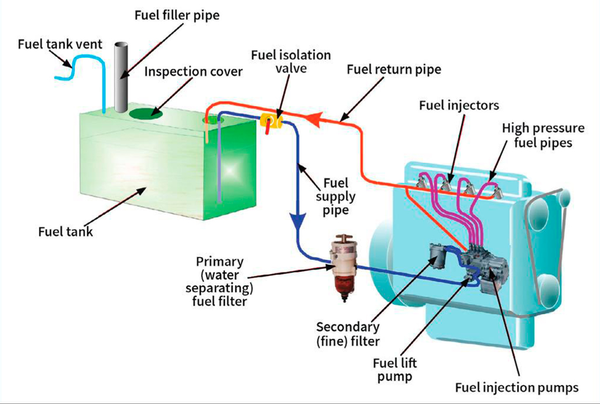
In our marketplace you can buy fuel tanks for yachts and motor boats from the best manufacturers of marine tanks - Nuova Rade, S.I.C. Divisione Elettronica, CAN - SB, etc.
The Importance of Accurate Fluid Level Monitoring
Like all measuring instruments, the tank level module consists of a set of measuring transducers and auxiliary devices necessary to carry out the measurement process. The primary transducer (sensor) perceives the measured value - the level - and converts it into an output signal supplied to subsequent transducers, or into readings read on a scale by the tank level module.
Methodological errors inherent in any process of measuring the level of liquids include: error in the orientation of the sensor in the vessel and temperature.
Level measurement can be continuous or point. Continuous level sensors measure the level over a given range and determine the exact amount of a substance at a specific location, while point level sensors only indicate whether the substance is above or below the sensing point. As a rule, the latter detect minimum or maximum permissible levels.
There are many factors that influence the choice of level measurement method. Selection criteria include the physical phase (in our case, liquid), temperature, pressure, chemical composition, dielectric constant of the medium, density (specific gravity) of the medium, mixing, acoustic or electrical noise, vibration, type of tank, its size and shape.
An error due to incorrect spatial orientation of the sensor arises due to inaccuracies in the installation of the vessel, installation of the tank level module sensor on it, deformation of the load-bearing elements of transported vessels during their filling and emptying, etc. All this ultimately leads to a mismatch in the level measurement path with a perpendicular to the interface between the media.
Currently, there is a diverse range of technical means that solve the problem of level measurement and control. Level measurement tools implement a variety of methods based on different physical principles. The most common methods of level measurement, which allow you to convert the level value into an electrical quantity and transfer its value to automatic control systems, include contact methods:
- waveguide;
- float;
- capacitive;
- hydrostatic;
- buoy, etc.
Non-contact methods include probing the liquid being measured with sound, electromagnetic radiation, and radiation.
The correct choice of level measurement method for a certain type of liquid, as well as the selection of sensors in exact accordance not only with the type of medium being measured, but also with the inputs of the system module - this guarantees the most accurate measurement of tank levels in real time and a timely sound signal when control the level values previously set for each tank will be violated.
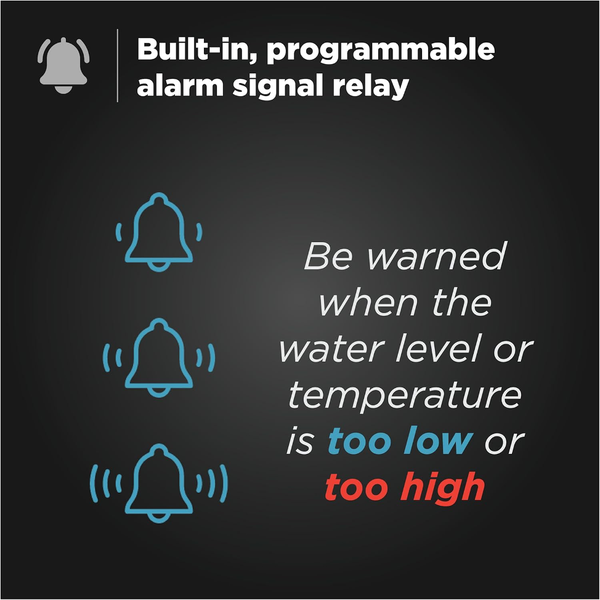
Long-time practicing sailors have at least once in their practice or in the sailing practice of their familiar skippers encountered the results of neglecting tank level control. It would be good if it ended with “just” a sewage overflow. You will simply spend a lot of time, many, many detergents, and even more nerves to get rid of dirt and stench, and also take a number of measures to prevent mold from appearing, including in the most inaccessible nooks and crannies of the yacht. Well, you know how many of them there are on any ship.
But that’s not even the worst result of neglecting tank level monitoring. Imagine that you are going on a coastal cruise and during one of the passages you did not pay attention to the excessive consumption of fresh water. Salvation awaits you in the nearest marina, but you will have to suffer from thirst.
Experience shows that on long voyages the crew more carefully monitors the condition of the fresh water tanks, but even here there can be cases of carelessness, especially if the ship has a desalination plant. How can this be, you say, since this is a guarantee of the constant availability of fresh water. Alas, any equipment has a habit of breaking down. So a supply of fresh water in a separate tank will not hurt, and where the tank is, there is control.
A critical decrease in the level in the fuel tank of a yacht has almost the same consequences as an empty tank of a car, just keep in mind that in this case, passing vehicles will not soon be able to help you - take you in tow or share fuel. In this case, we do not recommend recalling your experience as motorists and adding various flammable liquids to the tank, even if you have a gasoline engine.
Types of Sensors, Advantages and Disadvantages
We have already talked about the importance of correctly selecting sensors for correctly monitoring the level of fuel tanks and various waters on a yacht.
When selecting sensors, pay special attention to their compatibility with the tank level module inputs. The Simarine ST107 digital tank level module provides the monitoring system with three voltage inputs and four resistance inputs.
In this case, you can monitor the level in tanks using resistance inputs using analog sensors or the temperature using resistive type sensors.
Through the voltage inputs, in addition to monitoring the batteries, you can monitor the level in the tanks using analog sensors. For the same purpose, custom sensors can be used here.
For resistance inputs, the sensor range is allowed from 0 Ohm to 65 kiloohm, and for voltage inputs, sensors with a range from 0 to 75 V are suitable.
Temperature monitoring in tanks is also important, so this level module makes it possible to obtain temperature values. Suitable sensors are shown in the figure below.
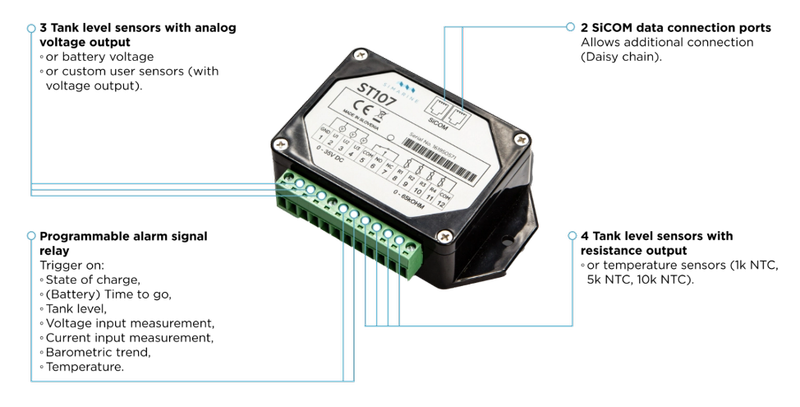
The choice of sensors according to their operating principle is also of great importance. Let's look at the characteristics of the most common categories.
Hydrostatic Sensors
The operating principle of hydrostatic sensors is based on measuring the pressure of a liquid column, the height of which is equal to the height of the liquid level in the vessel. Hydrostatic pressure is measured either using two pressure gauges or one differential pressure gauge.
Hydrostatic sensors measure the level of an open and closed tank, and the technology varies.
Hydrostatic tank level sensors are used for:
- continuous monitoring of pressure and level of water or other liquids of different densities, contamination and aggressiveness;
- measuring gas levels in tanks;
- recording data on the state of the measurement environment for subsequent use in an automated system;
- alarms for certain events (for example, reaching a certain temperature and level);
- control and monitoring of storage emptying;
- monitoring the draft and position of the vessel.
Their advantages are low cost, ease of operation, compatibility with any tanks and any liquids, the ability to operate in a wide range of pressures and temperatures, as well as in the presence of foam and rough surfaces.
Among the disadvantages that are significant for use in transport, we can note the possibility of changes in the density of the liquid affecting the measurement accuracy.
Hydrostatic sensors with mechanical sensing elements are characterized by ease of installation and maintenance, and high reliability. However, their sensitive element is in direct contact with the controlled environment, which in some cases requires the use of special materials for sensors and significantly narrows the scope of their use. One of the types of hydrostatic sensors – piezometric – is free from this drawback.
Ultrasonic Sensors
In ultrasonic sensors, the main elements are electronic circuits. They produce an ultrasonic pulse that passes through the air in the tank and is reflected to the sensor from the liquid/air interface. The time it takes for the reflected signal to return is the main criterion for measuring liquid level.
There is also a type of acoustic overhead level switches. Sensors of this type are designed to be located outside the container and record the moment of filling to a certain level.
Among other things, there are ultra-low frequency level meters, which are less common. Therefore, of the non-contact type sensors, the most affordable and practical are acoustic level meters.
Radar sensors can also be classified as acoustic. They operate on the principle of reflecting sound vibrations in the plane of separation of the liquid medium and gas. Sensors of this type do not have the possibility of contact with raw materials, which makes it possible to use them with aggressive substances, under harsh conditions of increased vaporization and gas formation. They have greater accuracy compared to ultrasonic ones, a smaller zone of immunity, and are suitable for use at high pressures in the tank.
Capacitive Sensors
The operation of capacitive level sensors is based on the difference in dielectric constant of liquids and air. The simplest primary transducer of a capacitive device is an electrode (metal rod or wire) located in a vertical metal tube. The rod together with the pipe form a capacitor. The capacity of such a capacitor depends on the liquid level, since when it changes from zero to maximum, the dielectric constant will change from the dielectric constant of air to the dielectric constant of liquid.
The advantages of this type of sensors are their simplicity of design and operation; ease of installation and maintenance; reliability and high measurement accuracy. They can be used in a wide range of process parameters, for continuous or point level measurement of liquids.
Among the disadvantages is the high sensitivity to changes in the electrical properties of liquids due to changes in their composition, temperature, etc. In addition, the formation of an electrically conductive or non-conducting film on the sensor elements due to the chemical activity of the liquid, condensation of its vapors, sticking of the liquid itself to those in contact with it elements, etc.
Non-metallic tanks, which are increasingly used on yachts, require an additional reference electrode. Calibration may be difficult.
Mechanical Float Sensors
Mechanical float measuring instruments are divided into narrow and wide range level meters.
Narrow-range float sensors are devices containing a spherical float made of stainless steel, which floats on the surface of the liquid and, through a rod and a special seal, is connected either to the pointer of the measuring device, or to a transducer of angular displacements into a unified electrical or pneumatic signal.
Wide range float sensors consist of a float connected to a counterweight by a flexible cable. At the bottom of the counterweight there is an arrow indicating the liquid level in the tank.
The scope of application of the float method of level measurement is very wide. It should not only be used in environments that cause sticking or deposits of sediment on the float. A typical application of float sensors is measuring the level of water of various compositions, fuels, oils, light petroleum products in relatively small containers and tanks. The float method can be successfully used in the case of foaming liquids, and for sticky media there are vibrating float liquid level indicators.
Pros of mechanical float sensors:
- simple design;
- reliable and easy to maintain;
- withstand high pressure and temperature;
- independence of measurements from the chemical state of the liquid;
- affordable price.
Cons:
- there is no self-diagnosis function, so it is recommended to carry out regular monitoring of their condition and maintenance;
- the moving parts of such alarms are susceptible to contamination by sticky or viscous liquids;
- the operation of the float may depend on fluctuations in the liquid;
- splashing and slight vibrations can distort the float readings.
Please note that they are not suitable for viscous liquids (diesel fuel, fuel oil, resins) due to the float sticking and enveloping it in a viscous medium.
So check your existing level and temperature sensors before installing a tank level module into your Simarine monitoring system.
Technologies Used in Tank Level Modules
Both wired and wireless solutions are available to integrate shunts and modules that can monitor the level of fuel or water tanks into the Simarine monitoring system. For the former, a data cable is used, 5 meters of which is supplied in each set of the ST107 module, SC503 and SC303 or Quadro shunts shunt and tank module SCQ25T.
PICO battery monitor systems and more advanced monitoring systems with Via Digital Patch Panels set and Nereide 2 set.


